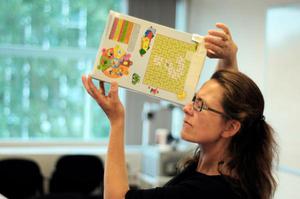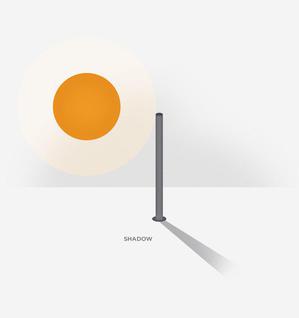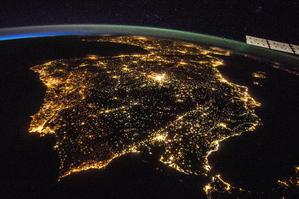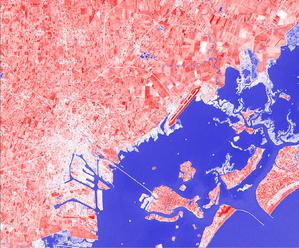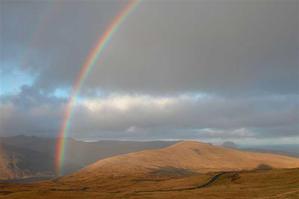Glossarbegriffe: Licht
Description: Licht ist elektromagnetische Strahlung. Im allgemeinen Sprachgebrauch bezieht sich Licht in der Regel auf elektromagnetische Strahlung mit einer Wellenlänge, die mit dem bloßen menschlichen Auge wahrgenommen werden kann. Die für den Menschen sichtbare Wellenlänge des Lichts liegt ungefähr im Bereich von 380-750 Nanometern (nm), wobei die meisten Menschen Licht mit einer Wellenlänge von weniger als 400 nm kaum wahrnehmen können. Dieser sichtbare Bereich ist ein schmaler Teil des elektromagnetischen Spektrums, das eine breite Palette von Wellenlängen abdeckt, von Gammastrahlen (die kürzesten) bis zu Radiowellen (die längsten). Im weiteren Sinne wird der Begriff Licht manchmal für jede Art von elektromagnetischer Strahlung verwendet.
Grundlegende Eigenschaften des Lichts sind Intensität, Ausbreitungsrichtung, Frequenz, Spektrum und Polarisation. Die Geschwindigkeit des Lichts im Vakuum ist mit genau 299.792.458 Metern pro Sekunde definiert und gehört zu den Grundkonstanten der Natur.
Die Farbe des Lichts hängt von seiner Wellenlänge ab. Violettes Licht hat die kürzeste Wellenlänge im sichtbaren Spektrum, rotes die längste. Licht hat mehrere Quellen, natürliche und künstliche; die Sonne ist die Hauptlichtquelle der Erde. Licht wird in kleinen "Paketen", als sogenannte Photonen, emittiert und absorbiert. Photonen haben sowohl die Eigenschaften von Wellen als auch von Teilchen. Dieses Phänomen wird als Welle-Teilchen-Dualismus bezeichnet.
Zugehörige Glossarbegriffe:
See this term in other languages
Term and definition status: The original definition of this term in English have been approved by a research astronomer and a teacher The translation of this term and its definition is still awaiting approval
The OAE Multilingual Glossary is a project of the IAU Office of Astronomy for Education (OAE) in collaboration with the IAU Office of Astronomy Outreach (OAO). The terms and definitions were chosen, written and reviewed by a collective effort from the OAE, the OAE Centers and Nodes, the OAE National Astronomy Education Coordinators (NAECs) and other volunteers. You can find a full list of credits here. All glossary terms and their definitions are released under a Creative Commons CC BY-4.0 license and should be credited to "IAU OAE".
Related Activities
Build a Safe Sun Viewer
astroEDU educational activity (links to astroEDU website) Description: Build a safe Sun viewer using cheap household items and learn why it is dangerous to look directly at the Sun, even briefly.License: CC-BY-4.0 Creative Commons Namensnennung 4.0 International (CC BY 4.0) icons
Tags: Hands-on , Safety Age Ranges: 6-8 , 8-10 , 10-12 Education Level: Primary , Secondary Areas of Learning: Modelling , Observation based Costs: Low Cost Group Size: Group Skills: Planning and carrying out investigationsSun’s Shadow
astroEDU educational activity (links to astroEDU website) Description: Why is the Sun's shadow so important?License: CC-BY-4.0 Creative Commons Namensnennung 4.0 International (CC BY 4.0) icons
Tags: Hands-on , Shadows Age Ranges: 6-8 , 8-10 , 10-12 , 12-14 , 14-16 Education Level: Informal , Middle School , Primary , Secondary Areas of Learning: Observation based , Social Research Costs: Medium Cost Duration: 1 day Group Size: Group Skills: Asking questions , Communicating information , Constructing explanations , Engaging in argument from evidenceHow Many Stars Can You See at Night?
astroEDU educational activity (links to astroEDU website) Description: Investigate the effects of light pollution on night sky observation.License: CC-BY-4.0 Creative Commons Namensnennung 4.0 International (CC BY 4.0) icons
Tags: Software , ecology , Observation of sky , Pollution , Constellations , stellarium Age Ranges: 12-14 Education Level: Middle School Areas of Learning: Observation based , Social Research Costs: Low Cost Duration: 45 mins Group Size: Group Skills: Analysing and interpreting data , Communicating information , Planning and carrying out investigationsA View from Above
astroEDU educational activity (links to astroEDU website) Description: How do satellites take images of the Earth surface and how do we analyse and use them?License: CC-BY-4.0 Creative Commons Namensnennung 4.0 International (CC BY 4.0) icons
Tags: Maps , Climate , Landsat , Earth observation , Sentinel , Copernicus , Remote sensing , Vegetation Age Ranges: 14-16 , 16-19 Education Level: Middle School , Secondary Areas of Learning: Social Research Costs: Low Cost Duration: 1 hour 30 mins Group Size: Group Skills: Analysing and interpreting data , Asking questions , Communicating information , Constructing explanations , Developing and using models , Engaging in argument from evidence , Using mathematics and computational thinkingReading the Rainbow
astroEDU educational activity (links to astroEDU website) Description: By understanding how rainbows work, you can discover about light and its properties, learning about stars, nebulae, galaxies, and our Universe.License: CC-BY-4.0 Creative Commons Namensnennung 4.0 International (CC BY 4.0) icons
Age Ranges: 14-16 , 16-19 , 19+ Education Level: Informal , Middle School , Secondary , University Areas of Learning: Interactive Lecture , Observation based , Social Research Costs: Low Cost Duration: 1 hour 30 mins Group Size: Group Skills: Analysing and interpreting data , Asking questions , Engaging in argument from evidenceHunting for spectra
astroEDU educational activity (links to astroEDU website) Description: Learn about light and spectra building a spectroscope with a CD!License: CC-BY-4.0 Creative Commons Namensnennung 4.0 International (CC BY 4.0) icons
Tags: Hands-on , Experiment , prism Age Ranges: 8-10 , 10-12 , 12-14 , 14-16 , 16-19 Education Level: Informal , Middle School , Primary , Secondary Areas of Learning: Guided-discovery learning Costs: Low Cost Duration: 1 hour Group Size: Individual Skills: Asking questions , Constructing explanations , Planning and carrying out investigationsLet there be light… but not too much!
astroEDU educational activity (links to astroEDU website) Description: Build a model to learn what light pollution is and what its effects are.License: CC-BY-4.0 Creative Commons Namensnennung 4.0 International (CC BY 4.0) icons
Tags: Pollution , sky observation , lighting source Age Ranges: 6-8 , 8-10 , 10-12 Education Level: Middle School , Primary Areas of Learning: Discussion Groups , Modelling , Observation based , Project-based learning Costs: Medium Cost Duration: 2 hours Group Size: Group Skills: Asking questions , Developing and using models , Engaging in argument from evidenceLight Play
astroEDU educational activity (links to astroEDU website) Description: A tinkering workshop to create a collective artwork with lightLicense: CC-BY-4.0 Creative Commons Namensnennung 4.0 International (CC BY 4.0) icons
Age Ranges: 6-8 , 8-10 , 10-12 , 12-14 Education Level: Middle School , Primary Areas of Learning: Fine Art focussed , Fun activity , Other , Problem-solving , Project-based learning Costs: Medium Cost Duration: several days Group Size: Group Skills: Asking questions , Communicating information , Constructing explanations , Engaging in argument from evidence